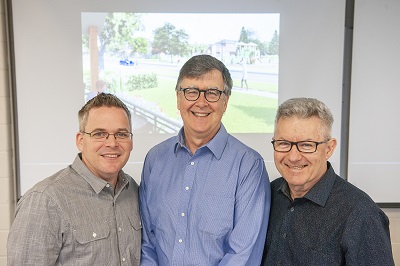Fanshawe students conceptualize innovative urban design ideas for net-zero community.
When you mix collaboration, creativity and an integrated learning experience, it gives Fanshawe students a solid foundation for their future career path thanks to an innovative urban design competition.
Inspired by the Marshall S. Huzevka Foundation, students from the GIS and Urban Planning and Architectural Technology programs joined forces to demonstrate how good urban design can imagine a new sustainable neighbourhood.
This year, the students were tasked with creating a vision for a parcel of land in Petrolia, owned by the Huzevka family, with an emphasis on forming a vibrant and healthy community. The criteria included providing a variety of sustainable housing sizes and types; promoting active transportation, such as walking and cycling; and creating a sustainable environment that reduces water consumption. Faculty members William Pol, Steve Ries and Russell Schnurr guided the students through the process and reinvented their course curriculum to make this project a possibility.
The Huzevka family began the foundation in honour of their late son Marshall, a student in Fanshawe’s Architectural Technology program, who died in a motorcycle accident in 1995. The Huzevkas approached Fanshawe’s Donald J. Smith School of Building Technology with the idea of creating a project that would be in memory of Marshall and the urban design competition began four years ago. The family held property that could provide a real life urban planning model and integrated learning experience. They liked the idea of giving students collective involvement in one of the programs where Marshall was once a student and felt great pride in being able to build a legacy for him.
Russell Schnurr, professor in Fanshawe’s School of Creative Industries, views the project as an excellent enrichment opportunity for students. “This is a unique, collaborative experience,” Schnurr says. “It’s an intensive seven-week project where students have to network with other students and faculty, from an entirely different program, to complete a complex, multi-disciplinary project that also includes a public presentation of their work.”
The students also conducted a site visit to the Huzevka property in Petrolia so they could better create their vision for how the land could be utilized. They also spoke with Rob Nesbitt, senior planner for the town of Petrolia, about community goals, the current set-up of nearby sub-divisions and about drainages and oil fields to help with their project planning. The students also went on a field trip to Sifton’s West 5, a net-zero community in London to help provide inspiration in their own projects. West 5 will offer sustainable mixed housing options and open green space with pathways for walking and running–criteria similar to the Huzevka project.
Five groups of 31 students recently presented in Petrolia in front of a jury of three architects and urban planners who judged each project. Approximately 20 community members and media also attended and had an interest in seeing the students’ vision for their town.
William Pol, professor in the Faculty of Creative Industries, always enjoys seeing how students apply their skills. “It’s amazing to see our students use the theories they have learned and create a design to match a community’s goals,” Pol says. “You help a town reimagine their space and provide inspiration.”
The Award of Excellence was given to team Urban Rise, comprised of Matheus Chiapetti, Alexandria Forman, Jamie Hood, Lauren Ouimet, Justin Soldo and Alex Van Haaren. Their design won based on the excellent connection of trails and streets to the town of Petrolia; promotion of a healthy and active lifestyle by incorporating multi-use pathways, generous open space and naturalized areas; and sustainable and affordable housing with a variety of semi-detached and townhouse styles and sizes.
For Fanshawe student Michael Upshall, the competition helped to expand his thoughts towards the building industry. “As a student in Architectural Technology, it was an amazing experience that helped me learn about sustainable living as well as urban design,” Upshall says. “The competition is a great opportunity for students.”
Those who attended the presentation were impressed by the students’ work, including the Huzevka family.
“This project gives students something they are craving: recognition in their hard-earned, focused studies in an effort to help people, the environment and ultimately, the future,” says Matt Huzevka, Marshall’s brother. “It's not often that I get a glimpse into the minds of our future generation, but I am extremely impressed.”
Steve Ries, professor in Fanshawe’s Faculty of Science, Trades and Technology, likes the hands-on experience the project gives students. “This is a real world project with real people and personalities,” Ries notes. “The students build more confidence in presenting their work and it gives them a great skill set for employment.”
Fanshawe is creating a new kind of community called Innovation Village – where the creativity of students and the wisdom of educators and mentors converge to advance innovation. This multidisciplinary and live client project is part of Innovation Village’s signature learning experience.
For more information, please visit www.fanshawec.ca/innovation.

Fanshawe professors Russell Schnurr, William Pol and Steve Ries stand in front of student work presented at the 2019 urban design competition.
For more information, please visit Fanshawe's media contact page.
Recent News Posts
-
Fanshawe reservist receives Helmets to Hardhats scholarship
Read MoreHelmets to Hardhats (H2H) is proud to announce that the first recipient of the Millwright Scholarship: Investing in our Future is enrolled at Fanshawe College. Matthew Steele is currently studying to -
Fanshawe announces Equity, Diversity and Inclusion Action Plan
Read MoreAfter two years of consultations with students, employees and community partners, Fanshawe College has officially launched its first Equity, Diversity and Inclusion (EDI) Action Plan. Over the next
